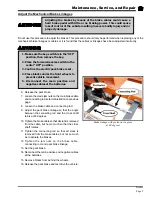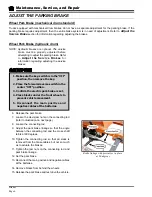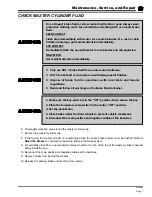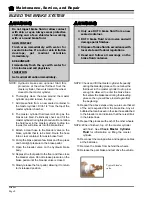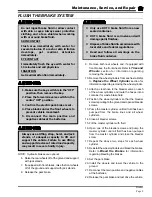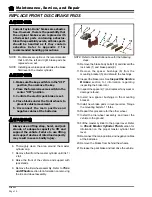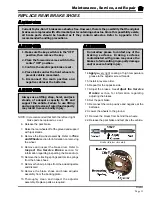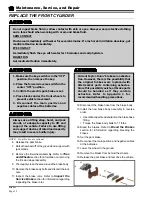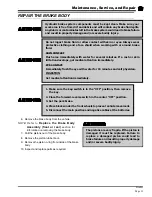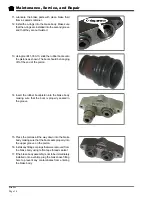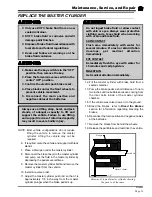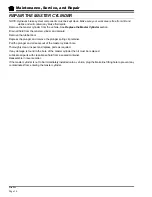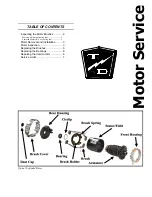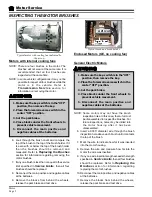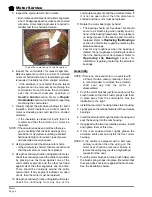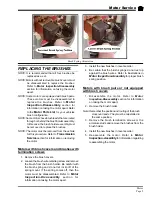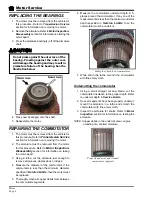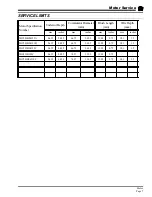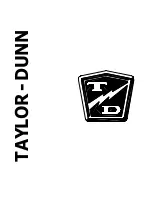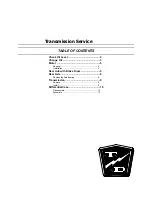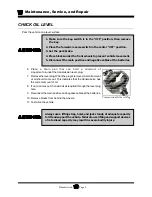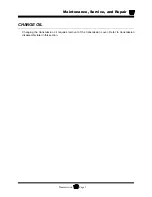
Maintenance, Service, and Repair
Brakes
Page 12
Do not ingest brake fluid or allow contact with skin or eyes. Always wear protective clothing
and a face shield when working with or around brake fluid.
SKIN CONTACT
Flush area immediately with water for several minutes. If a rash or skin irritation develops, get
medical attention immediately.
EYE CONTACT
Immediately flush the eye with water for 15 minutes and call physician.
INGESTION
Get medical attention immediately.
REPLACE THE FRONT CYLINDER
NOTE: Front brakes are optional.
6. Release the park brake.
7. Raise the wheel off of the ground and support with
jack stands.
8. Remove the tire/wheel assembly. Refer to
Tires
and Wheels
section for information on removing
the tire and wheel assembly.
9. Thoroughly clean the area around the brake body.
10. Remove the brake body bolts and discard the lock
nuts.
11. Inspect the brake rotor. Refer to
Inspect the
Service Brake
section for information regarding
inspecting the brake rotor.
1. Make sure the key-switch is in the “OFF”
position, then remove the key.
2. Place the forward-reverse switch in the
center “OFF” position.
3. Confirm the electric park brake is set.
4. Place blocks under the front wheels to
prevent vehicle movement.
5. Disconnect the main positive and
negative cables at the batteries.
Always use a lifting strap, hoist, and jack
stands, of adequate capacity to lift and
support the vehicle. Failure to use lifting
and support devices of rated load capacity
may result in severe bodily injury.
12. Disconnect the brake hose from the brake body.
13. Install the new brake body assembly in reverse
order.
•
Use teflon tape thread sealant on the brake hose
fitting.
•
Torque the brake body bolts to 11 ft-lbs.
14. Bleed the brakes. Refer to
Bleed the Brakes
section for information regarding bleeding the
brakes.
15. Set the park brake.
16. Reconnect the main positive and negative cables
at the batteries.
17. Lower the wheel to the ground.
18. Remove the blocks from behind the wheels.
19. Release the park brake and test drive the vehicle.
Current Taylor-Dunn
®
brakes are asbestos
free. However, there is the possibility that
the original brakes were replaced with
aftermarket parts containing asbestos.
Since this possibility exists, all brake parts
should be handled as if they contain
asbestos. Refer to Appendix C for
recommended handling precautions.
Summary of Contents for B 1-50
Page 2: ......
Page 6: ...TAYLOR DUNN ...
Page 14: ...Model B 1 00 ...
Page 30: ...TAYLOR DUNN ...
Page 36: ...TAYLOR DUNN ...
Page 52: ...TAYLOR DUNN ...
Page 66: ...Maintenance Service and Repair Steering Page 14 Exploded View of Steering Gear ...
Page 90: ...TAYLOR DUNN ...
Page 124: ...TAYLOR DUNN ...
Page 130: ...TAYLOR DUNN ...
Page 161: ...Wire Diagrams ...
Page 194: ...Illustrated Parts PARTS PAGE 10 Front Suspension 4 3 2 1 5 10 6 8 9 7 11 12 ...
Page 202: ...Illustrated Parts PARTS PAGE 18 Motor 2 3 5 6 4 7 8 1 9 10 Armature 9 ...
Page 206: ...Illustrated Parts PARTS PAGE 22 Wheels and Tires Ref wheel hub 1 2 5 assembly 4 3 6 7 8 9 ...
Page 208: ...Illustrated Parts PARTS PAGE 24 Instrument Panel dash ...
Page 217: ...Illustrated Parts PARTS PAGE 33 This page intentionaly left blank ...
Page 220: ...Illustrated Parts PARTS PAGE 36 Seat Cushions Deck and Lights B 1 50 ...
Page 222: ...Illustrated Parts PARTS PAGE 38 Seat Cushions Deck and Lights MX 1600 ...
Page 224: ...Illustrated Parts PARTS PAGE 40 Decals B 1 50 VIEW FROM INSIDE OF COWL 1 2 3 4 5 6 7 8 9 ...
Page 230: ...Illustrated Parts PARTS PAGE 46 Stake Sides B 1 50 1 2 3 4 5 6 7 8 ...








